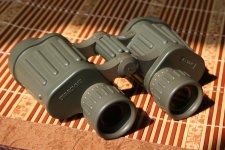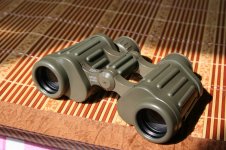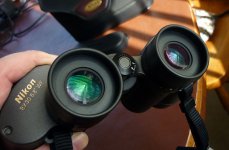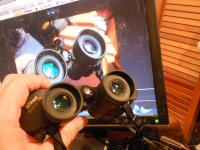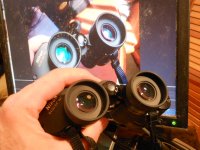A while back I had been looking for a pair of the elusive Nikon 8x30 EII binoculars with the GREEN coatings on the lenses. Recently there has been quite a few Nikon 8x30 EII bins on the internet (Ebay) however these do not appear to have the greenish tinted coatings. Are these coatings every bit as good as the earlier coatings, or perhaps better ? Has anyone out there done a review or comparison ?
Yes, I've compared both versions, and to my eyes, the newer black body coatings are better.
Both the gray body and black body versions have some green and magenta reflecting off the lenses, but with the older gray body, the dominant color is emerald green whereas the dominant color coming off the black body model's lenses is magenta.
I took photos of each model posed next to Norm's (Hey! Norm) photo, and the gray body more closely matches his photo (the light isn't at quite as steep an angle, so the photos don't show the difference as clearly as I can see with my eyes). The BB EII shows magenta at the same angle and lighting.
As to what this means in and of itself, I don't know. I have read some reviewers write that the dominate color reflecting off the lenses means that color is being transmitted less. So you would find a dip in that part of the spectrum in a light graph. This seems to hold up in the case of the FL where the dominate color being reflected is red and the light graph shows a steep fall off in the red.
Then there's the Edz Cloudy Nights School of Thought, which says the color reflecting off the lenses doesn't matter.
A third "school" emerged this year when a Swaro rep responded to someone's query about why the colors reflecting off the lenses of the 8x32 SV EL were different than the 8.5x42 model. He said it was because the coatings are matched to the lenses, which implied that the 8x32 has a different lens system than its bigger brother.
Whatever the reason, what matters is what you see in the field, and what I see in the field is better contrast, a brighter image, and less flaring with the magenta reflecting black body EII.
The first photo shows the gray body's reflections and the second, the black body's (click on photos to see them full size, and then click again to enlarge them further).
Brock





